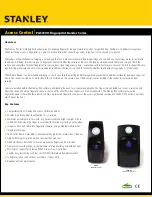
Appendix A
Specifications
DIO 6533 User Manual
A-6
© National Instruments Corporation
Handshaking
Direction ............................................ Input or output
Modes ................................................ 6 (burst, level-ACK,
leading-edge pulse,
trailing-edge pulse, long pulse,
and 8255 emulation)
Transfer rate
1
(max)
PCI-DIO-32HS ............................ up to 76 MB/s
(19 MS/s) at 32 bits;
up to 38 MB/s
(19 MS/s) at 16 bits;
up to 19 MB/s
(19 MS/s) at 8 bits
PXI-6533 ..................................... up to 64 MB/s
(16 MS/s) at 32 bits;
up to 34 MB/s
(17 MS/s) at 16 bits;
up to 19 MB/s
(19 MS/s) at 8 bits
AT-DIO-32HS ............................. up to 1.8 MB/s
(450 kS/s) at 32 bits;
up to 1.8 MB/s
(900 kS/s) at 16 bits;
up to 1.8 MB/s
(1.8 MS/s) at 8 bits
1. Handshaking rates depend on your computer, software, other bus activity, and handshaking protocol. The rates
shown were measured using NI-DAQ software and the burst-mode handshaking protocol, performing continuous
waveform generation using 100,000-point or larger buffers, with no other DAQ operations in progress. The PCI-
DIO-32HS, PXI-6533, and AT-DIO-32HS handshaking rates are DMA-based and do not necessarily increase as the
speed of the computer increases. The PCI-DIO-32HS and AT-DIO-32HS rates shown were measured on a sample
100 MHz Intel Pentium-based computer with an Intel 430FX (Triton I) chip set. The PXI-6533 rates were measured
using a 133 MHz Pentium CompactPCI controller with a Triton I chip set. The DAQCard-6533 rates do tend to
increase as the speed of the computer increases. The DAQCard-6533 75 MHz Pentium rates were measured using a
75 MHz Pentium computer with the Triton I (430FX) chip set. The DAQCard-6533 133 MHz Pentium rates were
measured using a 133 MHz Pentium computer with the Natoma (430HX) chip set. The DAQCard-6533 266 MHz
Pentium II rates were measured using a 266 MHz Pentium II computer with the Natoma (440FX) chip set.
















































